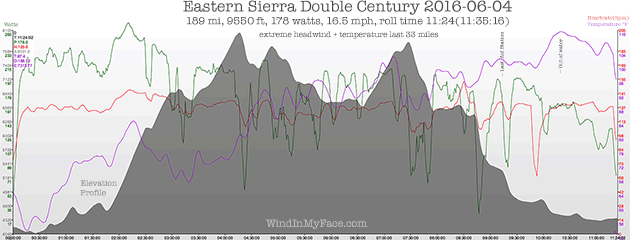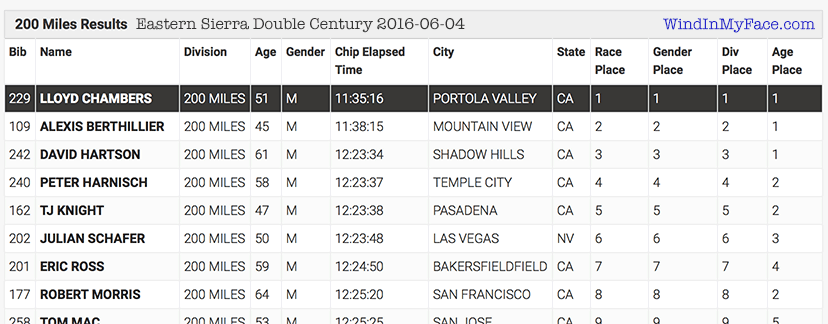2016 Eastern Sierra Double Century: a Win in Spite of Extreme Conditions and No Aid at the Worst Section
In spite of what felt like impending heatstroke, I won the Eastern Sierra Double Century (see the page for Eastern Sierra Double Century also).
It all started out great, I was feeling strong, and by Tom’s place at mile ~45 I had dropped all the fastest riders, the fastest of which had been drafting the tandem of all things. Not my style at all: I soloed it, taking no drafts as I have done for the last 25 or so doubles. I found myself outclimbing everyone by the end of the big climb to Tom’s Place. By the Mammoth Lakes area I had passed most of the 5:00 AM riders as well. I was on a roll.
Note that most if not all of these riders drafted, and some started at 5:00 AM and so got a full hour of cooler temperatures.
As the heat began to build past mile ~100 or so, my power dropped off a little, but nothing significant. It was now getting lonely with no one else around. My choice of the Lightweight Autobahn front wheel proved a liability as gusty windys caused disconcerting instability, forcing me to scrub of speed on many downhills. I also lost time dropping my map once and my water bottle another time, forcing me to stop and backtrack.
Final leg: extreme heat and wind, no aid station
All was going well until the last checkpoint at mile 155. I knew I was somewhat dehydrated (but not thirsty). Here is what I did at the last checkpoint:
- Rested a few minutes.
- Drank a full can of ice cold Mountain Dew.
- Filled two 1-liter bottles with water.
- Filled a 3rd for dousing myself as well.
- I do not recall any mention of further aid, so I thought the above would be plenty.
Leaving the aid station at mile 155, I turned ontoHwy 6 with 34 miles to go. Temperatures were now over 100°F, and rising towards Chalfant. But there was also a “hair dryer headwind” which I estimate as at least 25 mph. Within a few miles, I realized with that kind of headwind, making even 12 mph was hard, which meant ~3 more hours to go (2:52 was the actual time for me from that point). Within a few miles my water was warm as bathwater, and with about 15 miles to go, my water was gone—all of it. I now regretted using that 3rd bottle to douse myself.
I was thirsty and hot. I stopped several times, hoping it would cool me, but each time I just got hotter: at 105°F or so and the brutal wind, my body temperature only continued to rise and my dehydration continuted unabated. I began to feel odd, and I seriously feared heatstroke. Things began to shut down badly, with massive power loss (see graph). I began to curse the race organizers for not having a crucially important aid station. I held out my water bottle to oncoming motorists, none of whom even took their foot off the gas.
Each time I stopped, I was panting like a dog just standing there. As the chart shows, my heart rate (red line) stayed practically contant at ~128 beats per minute, even when stopped and not moving at all—a clear sign that the body is having serious difficulty eliminating heat, and a likely precursor of heatstroke. Finally, for the last few miles it began to cool slightly, and the road finally turned out of the wind as Bishop was approached—this helped.
As for the finish, I was so wiped I just sat with my body drooping at the door. A few people looked concerned, but no one came out to help—I had to ask for the race organizer who was not exactly quick about it. I told her of dangerous conditions and no aid, no ice, no water (she absolved herself by saying that Chalfant had water, see next para). When I asked her for water, she brought me a 2 oz cup and left. Only by the grace of the teenage daughter of another rider did I get cup after cup of ice water until I began to recover. My entire body was shiny with heavy droplets of sweat in the now air-conditioned room. In retrospect, I am dumbfounded at the callous disregard for my condition, which might have been dangerous (me or anyone). Does this person have any medical sense at all?
As noted above, the race organizer claimed (after I had finished) that there was water at Chalfant for hosing down or whatever (I’m not clear on what exactly was or was not there). But this (a) not mentioned on the cue sheet, (b) I recall no one telling me that at the last aid station, (c) I saw no signs or markings so indicating and there was no one there to flag riders, (e) when under duress, riders are less aware; they need a bit of help. Under the extreme conditions, at best this very poor planning. At worst, it was irresponsible and potentially dangerous (heatstroke and dehydration, hyponotremia).
Poor planning, particularly under the conditions
I have serious concerns about the competency of Planet Ultra in running this event. That is, poor planning and a disregard for potentially dangerous conditions. [Planet Ultra also runs the Solvang Spring Double; it is my view (which I cannot prove of course) that they made me sick two years in a row by using garden hoses to fill water jugs from a public restroom. I no longer use that rest stop, and I send ahead extra bottles].
The race details have an admonition that faster riders must start at 6:00 AM, not 5:00 AM.
“Mass” start at 5am for riders needing 12-17 hours to finish. All riders expecting to finish in under 12 hours must start at 6 AM.
When I pointed out to the race organizer this meant that the fast riders would be riding in extreme heat, I was shocked. First, it was clear that the suggestion was not even understood as to its merits; the idea was dismissed out of hand (unrelated suggestions in past years were met similar disinterest and apparent lack of comprehension, this is not the first time). Isn’t it obvious that starting one hour earlier trades one hour of the coolest part of the day for one hour of the hottest?
The last checkpoint was at mile 154.9. Then 36 miles to go in 105° F heat straight into a 25 mph (maybe stronger) headwind. Meaning a 2-3 hour effort into extreme dessication conditions with no aid station. I am certain I was losing at least 2 liters per hour of body fluid, if not 3 liters. This was/is risky to riders. The lack of an aid station was/is unacceptable, and given the extreme conditions calls into question the judgment and competence of the race organizer. See previous notes above on the claimed water at Chalfant.






